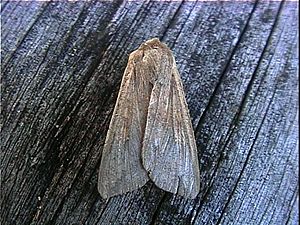Oriental armyworm facts for kids
Quick facts for kids Oriental armyworm |
|
|---|---|
 |
|
| Scientific classification | |
| Kingdom: | |
| Phylum: | |
| Class: | |
| Order: | |
| Family: | |
| Genus: | |
| Species: |
M. separata
|
| Binomial name | |
| Mythimna separata Walker, 1865
|
|
| Synonyms | |
|
|
The Oriental armyworm, also known as the northern armyworm or rice ear-cutting caterpillar, is a type of moth from the family Noctuidae. You can find it in places like China, Japan, South-east Asia, India, eastern Australia, New Zealand, and some Pacific islands. This moth is a big problem for maize (corn) crops in Asia because its caterpillars eat the plants. Francis Walker first described this species in 1865.
Contents
Why is it Called an Armyworm?
The name "armyworm" comes from how these caterpillars move. They spread out in a line, like an army, across fields or lawns. Then, they slowly "march" forward, eating all the leaves and plants they find in their path. This behavior can cause a lot of damage to crops.
What Does it Look Like?
The adult Oriental armyworm moth has a wingspan of about 35 to 50 millimeters (1.4 to 2 inches). Its front wings are usually grayish-yellow with a hint of dark-grey or reddish-yellow. They have light spots with blurry edges. The hindwings are grey.
Caterpillar Appearance
The caterpillars, which are the larval stage, usually go through six or sometimes seven growth stages called instars. When fully grown, a caterpillar can be up to 40 millimeters (1.6 inches) long. They have two wide black-brown stripes and one lighter stripe down their back. They also have a black-brown stripe along their sides.
Life Cycle and Habits
Adult moths fly from January to April, depending on where they live. The female moths lay tiny, spherical, milky-white eggs. These eggs hatch into the hungry caterpillars.
What Do They Eat?
The caterpillars love to eat many farm plants. Their favorite foods include corn, sorghum, and rice. Because they eat these important crops, they are considered a major pest. Interestingly, they do not eat the bitter melon plant. This is because bitter melon has a natural chemical called momordicine II, which stops the caterpillars from eating it.
Outbreaks and Damage
China often has big outbreaks of the northern armyworm. This means that suddenly, there are huge numbers of these caterpillars. A very serious outbreak happened in 2012, causing a lot of damage to crops.
How to Control Them
Farmers and scientists use different methods to control Oriental armyworms.
Simple Control Methods
- Hand-picking: Caterpillars can be picked off plants by hand.
- Pheromone traps: Adult moths can be attracted to special traps using chemicals called pheromones.
- Water management: Controlling the water level in fields can help.
- Removing host plants: Getting rid of other plants that the armyworms like to eat from around the fields can reduce their numbers.
Natural Control Methods
- Ducks: Ducks are very helpful! They can find and eat caterpillars hiding in the soil or at the bottom of plants.
- Parasitic insects: Other insects, like Cotesia ruficrus and Eupteromalus parnarae, can be introduced. These insects lay their eggs inside the armyworm caterpillars, which then kills the caterpillars.
Modern Control Methods
- Pesticides: Special pesticides and weedicides can be used carefully in fields.
- Integrated Pest Management: Governments and farmers often work together using a plan called Integrated Pest Management (IPM). This plan combines many different control methods to manage pests in the best way possible, using fewer chemicals.
Images for kids
See also
 In Spanish: Mythimna separata para niños
In Spanish: Mythimna separata para niños



